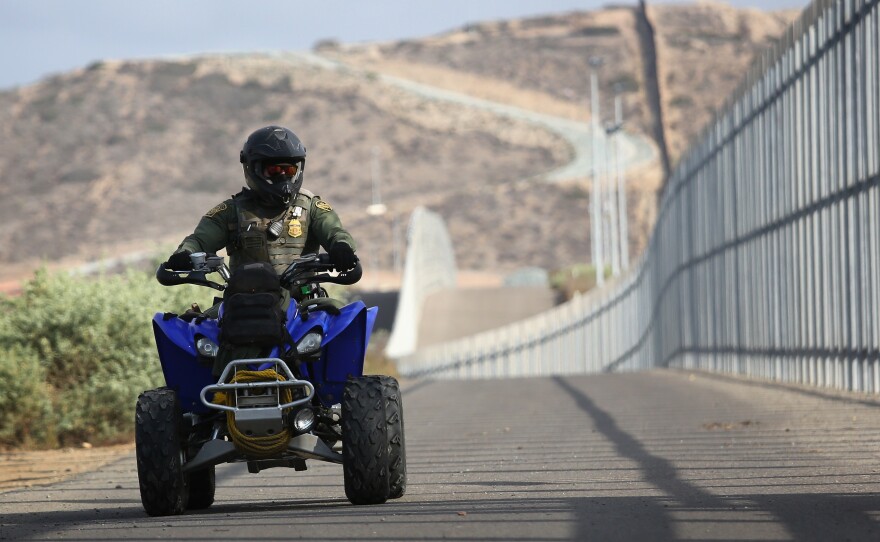A case now before the courts in Texas may set a precedent in alleged racial profiling cases brought against the Border Patrol.
If it succeeds, it would open a pathway for people judged by the courts to have been unlawfully seized in roving patrols to sue an individual agent, not simply the Border Patrol as an institution.
Roving patrols are separate from immigration checkpoints placed within 100 miles of the border with Mexico.
With respect to internal immigration checkpoints, Border Patrol agents have the right to question drivers and passengers. That's based on a case known as U.S. vs Martinez-Fuerte that was adjudicated in 1976.
Martinez-Fuerte was decision by the U.S. Supreme Court that said checkpoints set up on public roads or highways leading to or away from the border with Mexico are not a violation of the U.S. Constitution's Fourth Amendement, one designed to protect people against arbitrary search and seizure.
Fixed immigration checkpoints are in part a legacy of a 1953 Department of Justice ruling that 100 miles is a "reasonable distance" to pull someone over without probable cause.
But roving patrols beyond that line are legally distinct, requiring a higher standard.
Agents working in the interior of the U.S., inland from the 100 mile demarcation, must have a “reasonable certainty” that a suspect recently crossed a border. In addition, the agent must have a “reasonable suspicion” that a person is involved in criminal activity, which can include being in the country without legal permission.
Immigration lawyer David Antón Armendáriz, who has won court challenges examining Border Patrol stops and searches made beyond 100 miles of the border, says roving patrols often violate the Fourth Amendment.
“There are a high number of arrests on any given day by these agents far from the U.S. border,” he said.
Armendáriz is now before the courts alleging that roving patrols sometimes engage in racial profiling. He contends that profiling became an issue in the post 9-11 creation of the Dep’t of Homeland Security, which in turn, he maintains, affected the Border Patrol.
“After the reorganization of all the agencies after 9-11, the Border Patrol shifted their primary responsibility from worksite enforcement to whatever was left. And that which was left is simply roving patrol," he continued.
"ICE, Immigration and Customs Enforcement, took over worksite enforcement. So you had these stations that had been there for an awful long time, and these agents who’d been there an awful long time. And their duties suddenly shifted.”
Statistics obtained under the Freedom of Information Act by reporter Jeremy Schwartz of the Austin American-Statesman bear that out.
He examined documents revealing that as recently as 2012, roving patrols made up the principal activity of agents in such places as San Angelo, Texas, 130 miles from border.
After a protracted effort to get the Border Patrol to forward the information, he also learned that agents arrested more than 40,000 people between 2005 and 2313 at nine inland Border Patrol stations in Texas, some as far as 350 miles from the border. That’s an average of 10 people a day.
Attorney Armendáriz alleges the arrest numbers are a result in many cases of racial profiling.
“They have learned to focus on certain types of vehicles and certain types of persons., namely Hispanic men in trucks," he said.
Attorney Liz Rogers in Texas said "the law goes all over the charts," in describing how different courts have different interpretation's of the Fourth Amendment's applicability to arrests made by federal agents.
She understands both sides of the issue. She was an Assistant U.S. Attorney before becoming an assistant Federal Public Defender. In both positions she focused on the U.S.-Mexico border.
“Many of us on the defense side believe that they stopped somebody ‘cause they looked Hispanic. In other parts of the country they call it ‘driving while black.’ But the Fifth Circuit overwhelmingly has supported law enforcement on those issues since the ‘70s,” she said.
The Fifth Circuit Court of Appeals includes Texas. But it has rendered other rulings showing that the 100 mile limit is legally blurry. In 2012 for example, the Fifth Circuit said the arrest of an undocumented immigrant 170 miles from the border was illegal.
“They can consider that someone is Hispanic," said Rogers. "But it can’t be the only reason.”
In another case described by reporter Jeremy Schwartz, a veteran agent’s deposition showed the agent had pulled over work crews far from the border. But the agent said only half the people stopped were arrested. That implies that many U.S. citizens and others with the legal right to live and work in the United States were also stopped.
And now, there’s another case pending before the Fifth Circuit launched by 24-year-old Alejandro Garcia de la Paz. He was in a car 90 miles from the border four years ago when an agent stopped him and three others on a country road.
“Oh my stomach was just shaking," Garcia de la Paz said. "I don’t know how you say it.”
In court documents, the agent claimed he stopped the car because ” the driver’s facial expression changed immediately upon making eye contact with me.”
Garcia de la Paz' lawsuit claiming the stop was illegal and based on racial profiling has now been argued before the Fifth Circuit. A decision is imminent.
For a variety of intersecting legal reasons, a victory would set a precedent, opening a door that could see individual agents sued for their wrongful action in a roving patrol.
In fact, Garcia de la Paz was in the United States illegally at the time of his arrest. The Border Patrol agent's instinct about Garcia de la Paz' immigration status was correct.
But in court filings, Garcia is maintaining that the Fourth Amendment applies to anyone on U.S. soil, whether here legally or otherwise. And there is case law that agrees with that notion.
Since his arrest, Garcia de la Paz has been allowed to stay in the U.S., at least temporarily. He's protected from deportation proceedings because he's covered by the Deferred Action for Childhood Arrivals Program. He was brought to the U.S. from Mexico illegally as an infant.
Called DACA, the program gives temporary relief from deportation and a temporary work permit to people aged 15-30 brought illegally to the U.S. as children, although the program does not provide a route to citizenship.
Legal experts interviewed for this story suggest say a decision will be delivered soon, possibly within weeks.
The Vice President of the National Border Patrol Council, Shawn Moran, says agents are entitled to make arrests anywhere. The council is the union representing Border Patrol agents.
“Border Patrol agents don’t pull out a map and look to see if they’re within a hundred miles," he said.
"If they encounter someone that is here illegally this country and does not have the proper documentation to remain here, they will be arrested and processed by Border Patrol agents," he said.
In an email, a senior Border Patrol official writes that the agency “does not tolerate racial profiling.”






